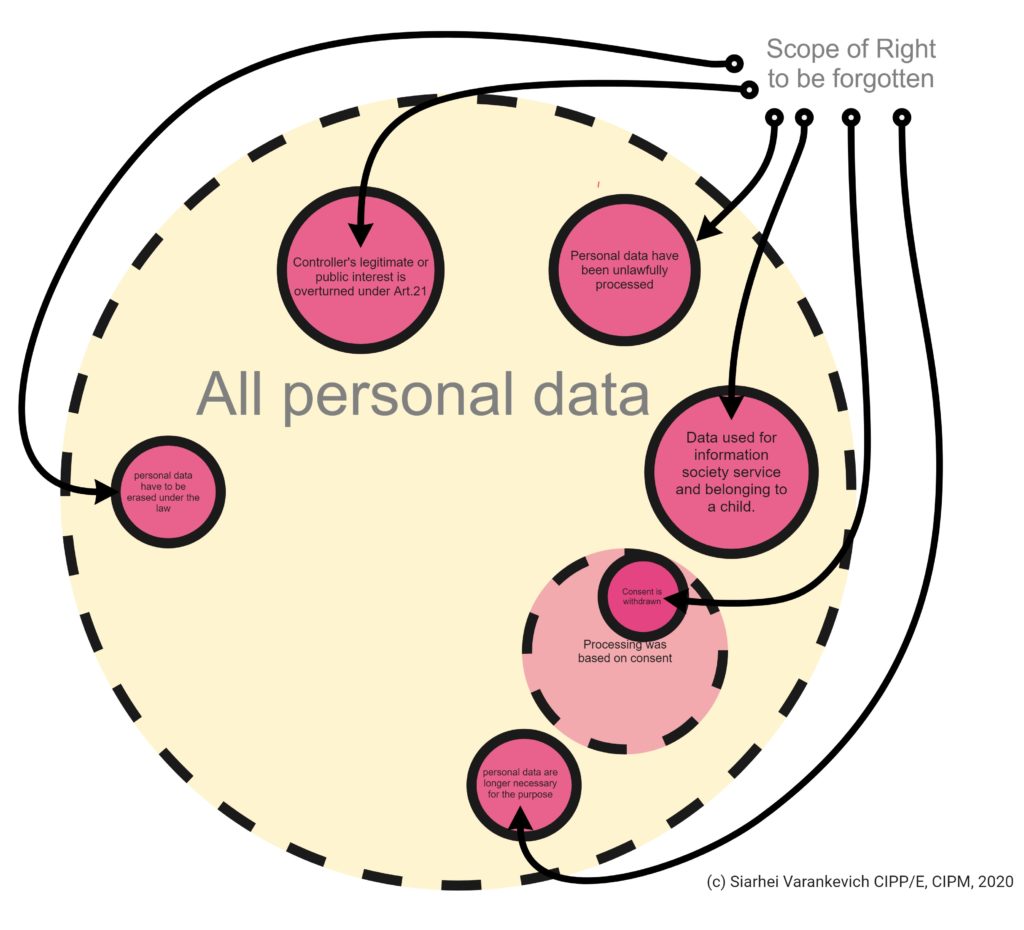Artikkel 17 GDPR. Õigus andmete kustutamisele („õigus olla unustatud“)
Article 17 GDPR. Right to erasure (‘right to be forgotten’)
1. Andmesubjektil on õigus nõuda, et vastutav töötleja kustutaks põhjendamatu viivituseta teda puudutavad isikuandmed ja vastutav töötleja on kohustatud kustutama isikuandmed põhjendamatu viivituseta, kui kehtib üks järgmistest asjaoludest:
1. The data subject shall have the right to obtain from the controller the erasure of personal data concerning him or her without undue delay and the controller shall have the obligation to erase personal data without undue delay where one of the following grounds applies:
a) isikuandmeid ei ole enam vaja sellel eesmärgil, millega seoses need on kogutud või muul viisil töödeldud;
(a) the personal data are no longer necessary in relation to the purposes for which they were collected or otherwise processed;
b) andmesubjekt võtab töötlemiseks antud nõusoleku tagasi vastavalt artikli 6 lõike 1 punktile a või artikli 9 lõike 2 punktile a ning puudub muu õiguslik alus isikuandmete töötlemiseks;
(b) the data subject withdraws consent on which the processing is based according to point (a) of Article 6(1), or point (a) of Article 9(2), and where there is no other legal ground for the processing;
c) andmesubjekt esitab vastuväite isikuandmete töötlemise suhtes artikli 21 lõike 1 kohaselt ja töötlemiseks pole ülekaalukaid õiguspäraseid põhjuseid või andmesubjekt esitab vastuväite isikuandmete töötlemise suhtes artikli 21 lõike 2 kohaselt;
(c) the data subject objects to the processing pursuant to Article 21(1) and there are no overriding legitimate grounds for the processing, or the data subject objects to the processing pursuant to Article 21(2);
e) isikuandmed tuleb kustutada selleks, et täita vastutava töötleja suhtes kohaldatava liidu või liikmesriigi õigusega ette nähtud juriidilist kohustust;
(e) the personal data have to be erased for compliance with a legal obligation in Union or Member State law to which the controller is subject;
2. Juhul kui vastutav töötleja on isikuandmed avalikustanud ja peab lõike 1 kohaselt isikuandmed kustutama, võtab vastutav töötleja kättesaadavat tehnoloogiat ja rakendamise kulusid arvestades tarvitusele mõistlikud abinõud, sealhulgas tehnilised meetmed, et teavitada kõnealuseid isikuandmeid töötlevaid vastutavaid töötlejaid sellest, et andmesubjekt taotleb neilt kõnealustele isikuandmetele osutavate linkide või andmekoopiate või -korduste kustutamist.
2. Where the controller has made the personal data public and is obliged pursuant to paragraph 1 to erase the personal data, the controller, taking account of available technology and the cost of implementation, shall take reasonable steps, including technical measures, to inform controllers which are processing the personal data that the data subject has requested the erasure by such controllers of any links to, or copy or replication of, those personal data.
(EN) ISO/IEC 27701, adopted in 2019, added additional ISO/IEC 27002 guidance for PII processors.
Here is the relevant paragraph to article 17(2) GDPR:
8.3.1 Obligations to PII principals
Control
The organization should provide the customer with the means to comply with its obligations related to PII principals.
Implementation guidance
A PII controller’s obligations can be defined by legislation, by regulation and/or by contract.
…
Logi sisse
terviktekstile juurdepääsuks
3. Lõikeid 1 ja 2 ei kohaldata sel määral mil isikuandmete töötlemine on vajalik
3. Paragraphs 1 and 2 shall not apply to the extent that processing is necessary:
(EN) ISO/IEC 27701, adopted in 2019, added additional ISO/IEC 27002 guidance for PII controllers.
Here is the relevant paragraph to article 17(3) GDPR:
7.2.2 Identify lawful basis
Control
The organization should determine, document and comply with the relevant lawful basis for the processing of PII for the identified purposes.
Implementation guidance
Some jurisdictions require the organization to be able to demonstrate that the lawfulness of processing was duly established before the processing.
…
Logi sisse
terviktekstile juurdepääsuks
a) sõna- ja teabevabaduse õiguse teostamiseks;
(a) for exercising the right of freedom of expression and information;
b) selleks, et täita vastutava töötleja suhtes kohaldatava liidu või liikmesriigi õigusega ette nähtud juriidilist kohustust, mis näeb ette isikuandmete töötlemise, või täita avalikes huvides olevat ülesannet või teostada vastutava töötleja avalikku võimu;
(b) for compliance with a legal obligation which requires processing by Union or Member State law to which the controller is subject or for the performance of a task carried out in the public interest or in the exercise of official authority vested in the controller;
d) avalikes huvides toimuva arhiveerimise, teadus- või ajaloouuringute või statistilisel eesmärgil kooskõlas artikli 89 lõikega 1 sel määral mil lõikes 1 osutatud õigus tõenäoliselt muudab sellise töötlemise eesmärgi saavutamise võimatuks või häirib seda suurel määral, või
(d) for archiving purposes in the public interest, scientific or historical research purposes or statistical purposes in accordance with Article 89(1) in so far as the right referred to in paragraph 1 is likely to render impossible or seriously impair the achievement of the objectives of that processing; or
The latest consolidated version of the Regulation with corrections by Corrigendum, OJ L 127, 23.5.2018, p. 2 ((EU) 2016/679). Source: EUR-lex.
(EN) The so-called “right to be forgotten” was hailed as a breakthrough with the adoption of the General Data Protection Regulation, even though it existed in a limited form before. Article 17 provides for a broader “right to erasure”, to take into account the exact wording of the provision. European Union residents have a right to ask for the deletion of their personal data, and the organization that holds the data has a corresponding obligation to erase them “without undue delay” under a certain number of circumstances.
…
Logi sisse
terviktekstile juurdepääsuks
(EN)
Data Subject Request Letter Sample
Concern: Request to erase my personal data
Dear Madam, Dear Sir,
You have data concerning me that I am asking you to delete…
…
Logi sisse
terviktekstile juurdepääsuks
(EN) ISO/IEC 27701, adopted in 2019, added additional ISO/IEC 27002 guidance for PII controllers.
Here is the relevant paragraph to article 17 GDPR:
7.3.6 Access, correction and/or erasure
Control
The organization should implement policies, procedures and/or mechanisms to meet their obligations to PII principals to access, correct and/or erase their PII.
Implementation guidance
The organization should implement policies, procedures and/or mechanisms for enabling PII principals to obtain access to, correct and erase of their PII, if requested and without undue delay.
…
Logi sisse
terviktekstile juurdepääsuks
(65) Andmesubjektil peaks olema õigus nõuda teda käsitlevate isikuandmete parandamist ja „õigus olla unustatud“ juhul, kui selliste andmete säilitamine rikub käesolevat määrust või vastutava töötleja suhtes kohaldatavat liidu või liikmesriigi õigust. Andmesubjektil peaks olema õigus oma isikuandmete kustutamisele ja nende töötlemise lõpetamisele eelkõige siis, kui isikuandmed ei ole enam vajalikud eesmärkidel, mille jaoks need koguti või neid muul viisil töödeldi, kui andmesubjekt on töötlemisele antud nõusoleku tagasi võtnud või kui ta on vastu oma isikuandmete töötlemisele või kui nende isikuandmete töötlemine muul viisil ei vasta käesoleva määruse nõuetele. Kõnealune õigus on asjakohane eelkõige siis, kui andmesubjekt andis nõusoleku lapsena, olemata täielikult teadlik töötlemisega kaasnevatest ohtudest, ja hiljem soovib need isikuandmed eelkõige internetist kustutada. Andmesubjektil peaks olema võimalik seda õigust kasutada, vaatamata sellele, et ta ei ole enam laps. isikuandmete jätkuv säilitamine peaks olema seaduslik aga juhul, kui see on vajalik sõna- ja teabevabaduse kasutamiseks, juriidilise kohustuse täitmiseks, avalikes huvides oleva ülesande täitmiseks või vastutava töötleja avaliku võimu teostamiseks, rahvatervise valdkonna avalikes huvides, avalikes huvides toimuva arhiveerimise, teadus- või ajaloouuringute või statistilisel eesmärgil või õigusnõuete koostamiseks, esitamiseks või kaitsmiseks.
(65) A data subject should have the right to have personal data concerning him or her rectified and a ‘right to be forgotten’ where the retention of such data infringes this Regulation or Union or Member State law to which the controller is subject. In particular, a data subject should have the right to have his or her personal data erased and no longer processed where the personal data are no longer necessary in relation to the purposes for which they are collected or otherwise processed, where a data subject has withdrawn his or her consent or objects to the processing of personal data concerning him or her, or where the processing of his or her personal data does not otherwise comply with this Regulation. That right is relevant in particular where the data subject has given his or her consent as a child and is not fully aware of the risks involved by the processing, and later wants to remove such personal data, especially on the internet. The data subject should be able to exercise that right notwithstanding the fact that he or she is no longer a child. However, the further retention of the personal data should be lawful where it is necessary, for exercising the right of freedom of expression and information, for compliance with a legal obligation, for the performance of a task carried out in the public interest or in the exercise of official authority vested in the controller, on the grounds of public interest in the area of public health, for archiving purposes in the public interest, scientific or historical research purposes or statistical purposes, or for the establishment, exercise or defence of legal claims.
(66) Selleks et tugevdada võrgukeskkonnas õigust olla unustatud, tuleks laiendada õigust andmete kustutamisele, kohustades isikuandmed avaldanud vastutavat töötlejat võtma tarvitusele mõistlikke abinõusid, sealhulgas rakendades tehnilisi meetmeid, et teavitada selliseid isikuandmeid töötlevaid vastutavaid töötlejaid asjaolust, et andmesubjekt taotleb neilt kõnealustele isikuandmetele osutavate linkide või andmekoopiate või -korduste kustutamist. Seda tehes peaks vastutav töötleja võtma mõistlikke meetmeid, võttes arvesse vastutavale töötlejale vastutavale töötlejale kättesaadavat tehnoloogiat ja vahendeid, sealhulgas tehnilisi meetmeid, et teavitada isikuandmeid töötlevaid vastutavaid töötlejaid andmesubjekti taotlusest.
(66) To strengthen the right to be forgotten in the online environment, the right to erasure should also be extended in such a way that a controller who has made the personal data public should be obliged to inform the controllers which are processing such personal data to erase any links to, or copies or replications of those personal data. In doing so, that controller should take reasonable steps, taking into account available technology and the means available to the controller, including technical measures, to inform the controllers which are processing the personal data of the data subject's request.
(EN)
Documents
Article 29 Working Party, Guidelines on the Implementation of the Court of Justice of the European Union Judgment on Google Spain Inc. v. Agencia Española de protección de datos (AEPD) and Mario Costeja González C-131/12 (2014).
EDPB, Guidelines 5/2019 on the Criteria of the Right to be Forgotten in the Search Engines Cases under the GDPR (part 1) (2019).
EDPB, Guidelines 02/2021 on Virtual Voice Assistants (2021).
Case law
CJEU, Google Spain SL/Agencia española de protección de datos, C-131/12 (2014).
CJEU, Camera di Commercio, Industria, Artigianato e Agricoltura di Lecce/Manni, C-398/15 (2019).
CJEU, GC e.a./Commission nationale de l’informatique et des libertés, C-136/17 (2019).
CJEU, Google LLC/Commission nationale de l’informatique et des libertés, C-507/17 (2019).






(EN)